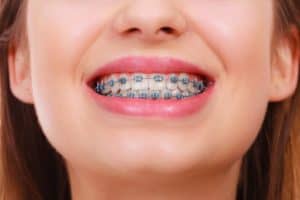Thinking about getting dental braces? Turns out they aren’t just for kids anymore. Even if your mouth has stopped growing, it doesn’t mean you can’t benefit from orthodontic treatment. It just might take a little longer. Good thing there are plenty of attractive options to ensure that the time you spend wearing dental braces won’t make you feel like your mouth is full of metal!
Dental braces help a dentist align your teeth and correct a malocclusion, or problem with your bite. But gone are the days of tinsel teeth and a tin grin! Mini braces are one of several more aesthetically appealing alternatives to traditional metal braces. Other options include porcelain dental braces (which look clear), Invisalign® and gold braces, even braces worn behind the teeth! Mini braces are miniature versions of their metal counterparts and combine the strength of stainless steel with a more discreet appearance.
No More Heavy Metal
Mini braces rely on the same technology as their larger metal counterparts: Metal brackets are attached to the front of your teeth and metal archwires attached to the brackets move the teeth. The difference is in the size — mini braces are about 30 percent smaller than traditional metal dental braces. They’re also made of a stronger grade of stainless steel than their larger counterparts, so you won’t sacrifice strength for size. Mini braces are substantially less noticeable than traditional metal braces and are easier to keep clean. The smaller size also means less discomfort to the inside of your mouth.
Mini braces are popular with adults and teens alike. Teenagers often choose to change up the ligature ties that go around the brackets every once in a while. This can be done during a routine visit with the dentist or orthodontist. Different colored elastics can be worn to show team spirit or mark holidays. Adults may opt to stick with more subdued silver elastics instead!
Even though the variety of dental braces has grown significantly in recent years, some things about orthodontics remain the same. Any orthodontic treatment plan begins with a consultation, when your dentist or orthodontist will observe your bite and determine which type of dental braces might be best for you. Treatment still takes a while — up to two years if you wear metal braces (possibly longer for adults). And after your dental braces come off, you’ll need to wear an orthodontic retainer while your teeth settle in to their new position.
Getting It Straight
The results of your hard work will be well worth it. Not only will your teeth look better, they will help you stay healthier, too. After all, straight teeth are easier to brush and floss, which means less chance of returning to your dentist for a tooth filling or gum disease treatment. Fixing a malocclusion will also reduce wear and tear on your teeth and help you chew better, reducing headaches and jaw pain.
Only a dentist or orthodontist can determine whether or not you need dental braces and if so, which type is right for you. Speak with your dentist to find out whether mini braces are an option.

